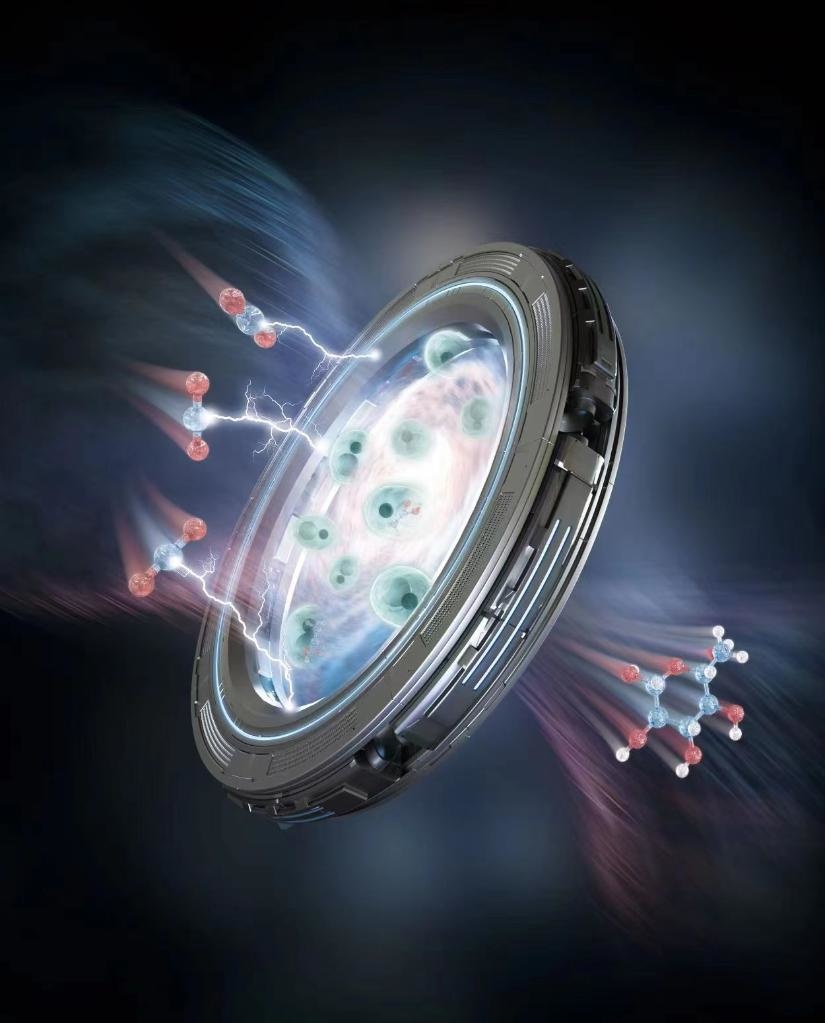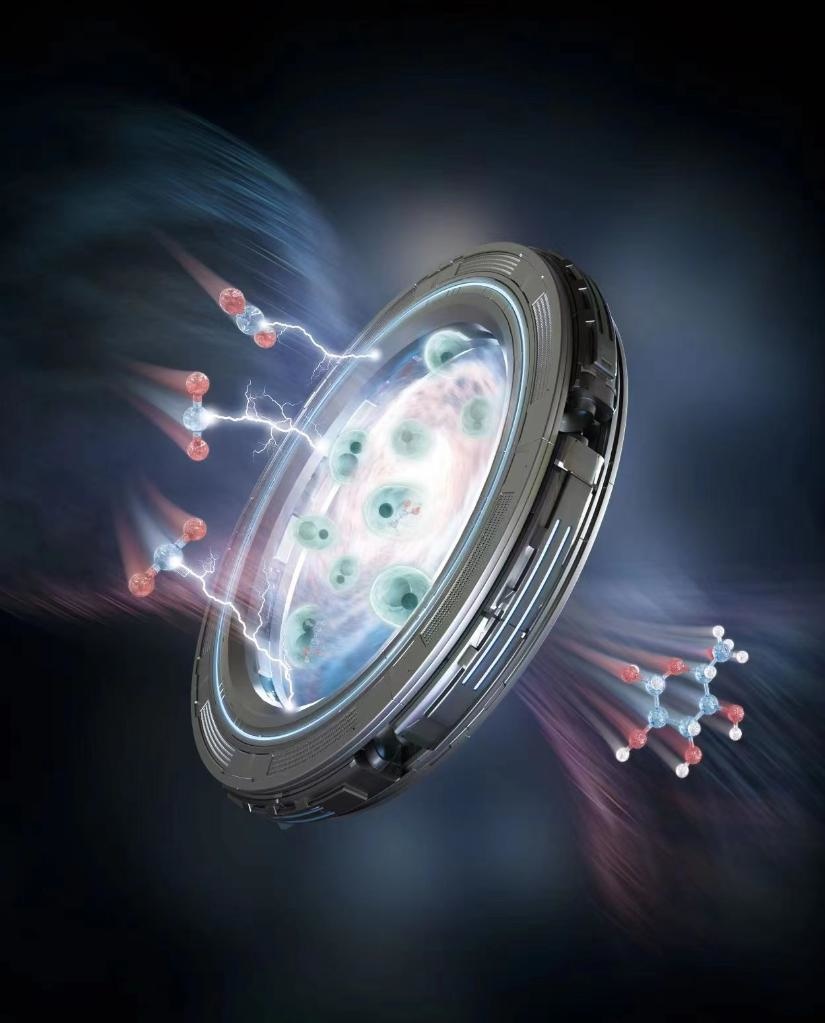By Wu Yuehui, People’s Daily

An illustration shows that carbon dioxide and water are converted into long-chain compounds by a hybrid electro-biosystem that couples spatially separate carbon dioxide electrolysis and biological fermentation. (Photo/Courtesy of the research teams)
Chinese scientists found new use of carbon dioxide following the success of synthesizing starch from carbon dioxide last September, the first of its kind globally.
The newly completed study has shown that through the combination of electro catalysis and biosynthesis, carbon dioxide can be efficiently reduced to synthesize high concentration of acetic acid, and then further translated into glucose and fatty acids by using microorganism.
The study was jointly conducted by three research teams led by Xia Chuan from the University of Electronic Science and Technology of China, Yu Tao from Shenzhen Institute of Advanced Technology under the Chinese Academy of Sciences (CAS), and Zeng Jie from the University of Science and Technology of China, respectively.
The study was published in the journal Nature Catalysis on April 28 and also featured on the cover of the journal.
“The study has contributed a new technique to the production of artificial or semi-artificial food,” said Li Can, an academician of the CAS and director of the catalysis committee of the Chinese Chemical Society (CCS).
To use carbon dioxide to produce glucose and fatty acids, the first step is to convert it into acetic acid under mild conditions. Acetic acid is not only the main component of vinegar, but also an excellent carbon source for biosynthesis and can be converted into glucose and other biological substances.
A new solid electrolyte reaction device employed by researchers has significantly increased the efficiency of the conversion from carbon dioxide into acetic acid and can realize the continuous production of acetic acid aqueous solution with a concentration of 97 percent for more than 140 hours, which is considered the most important highlight of the study by industry insiders.
Using microorganism to produce glucose is the second step.
“Brewer’s yeast is mainly used for fermentation in the production of food like cheese, steamed bun, and spirits. It is also often used as a model organism for microbial manufacturing and research in cell biology,” said Yu.
This process can be understood as converting carbon dioxide into vinegar and feeding the yeast to produce glucose and fatty acids, according to Yu.
The study has pioneered a new strategy for the production of food products including glucose through the combination of electrochemistry and living cell catalysis, provided a new example for further development of new agriculture and bio manufacturing driven by electric power, and represented an important direction in the utilization of carbon dioxide, said Deng Zixin, an academician of the CAS and director of State Key Laboratory of Microbial Metabolism, Shanghai Jiao Tong University.
The upcycling of carbon dioxide into value-added products represents the tantalizing possibility of a renewable-electricity-driven manufacturing industry and a substantially untapped opportunity to tackle environmental issues and achieve a circular economy, the researchers said.
“With an electrolyte reactor and different microorganisms, we can produce starch, pigment or medicines in the future,” said Xia Chuan, the paper’s co-corresponding author from the University of Electronic Science and Technology of China.
The newly completed study has shown that through the combination of electro catalysis and biosynthesis, carbon dioxide can be efficiently reduced to synthesize high concentration of acetic acid, and then further translated into glucose and fatty acids by using microorganism.
The study was jointly conducted by three research teams led by Xia Chuan from the University of Electronic Science and Technology of China, Yu Tao from Shenzhen Institute of Advanced Technology under the Chinese Academy of Sciences (CAS), and Zeng Jie from the University of Science and Technology of China, respectively.
The study was published in the journal Nature Catalysis on April 28 and also featured on the cover of the journal.
“The study has contributed a new technique to the production of artificial or semi-artificial food,” said Li Can, an academician of the CAS and director of the catalysis committee of the Chinese Chemical Society (CCS).
To use carbon dioxide to produce glucose and fatty acids, the first step is to convert it into acetic acid under mild conditions. Acetic acid is not only the main component of vinegar, but also an excellent carbon source for biosynthesis and can be converted into glucose and other biological substances.
A new solid electrolyte reaction device employed by researchers has significantly increased the efficiency of the conversion from carbon dioxide into acetic acid and can realize the continuous production of acetic acid aqueous solution with a concentration of 97 percent for more than 140 hours, which is considered the most important highlight of the study by industry insiders.
Using microorganism to produce glucose is the second step.
“Brewer’s yeast is mainly used for fermentation in the production of food like cheese, steamed bun, and spirits. It is also often used as a model organism for microbial manufacturing and research in cell biology,” said Yu.
This process can be understood as converting carbon dioxide into vinegar and feeding the yeast to produce glucose and fatty acids, according to Yu.
The study has pioneered a new strategy for the production of food products including glucose through the combination of electrochemistry and living cell catalysis, provided a new example for further development of new agriculture and bio manufacturing driven by electric power, and represented an important direction in the utilization of carbon dioxide, said Deng Zixin, an academician of the CAS and director of State Key Laboratory of Microbial Metabolism, Shanghai Jiao Tong University.
The upcycling of carbon dioxide into value-added products represents the tantalizing possibility of a renewable-electricity-driven manufacturing industry and a substantially untapped opportunity to tackle environmental issues and achieve a circular economy, the researchers said.
“With an electrolyte reactor and different microorganisms, we can produce starch, pigment or medicines in the future,” said Xia Chuan, the paper’s co-corresponding author from the University of Electronic Science and Technology of China.
 Menu
Menu
 Chinese scientists contribute new technique to production of artificial or semi-artificial food from carbon dioxide
Chinese scientists contribute new technique to production of artificial or semi-artificial food from carbon dioxide
















